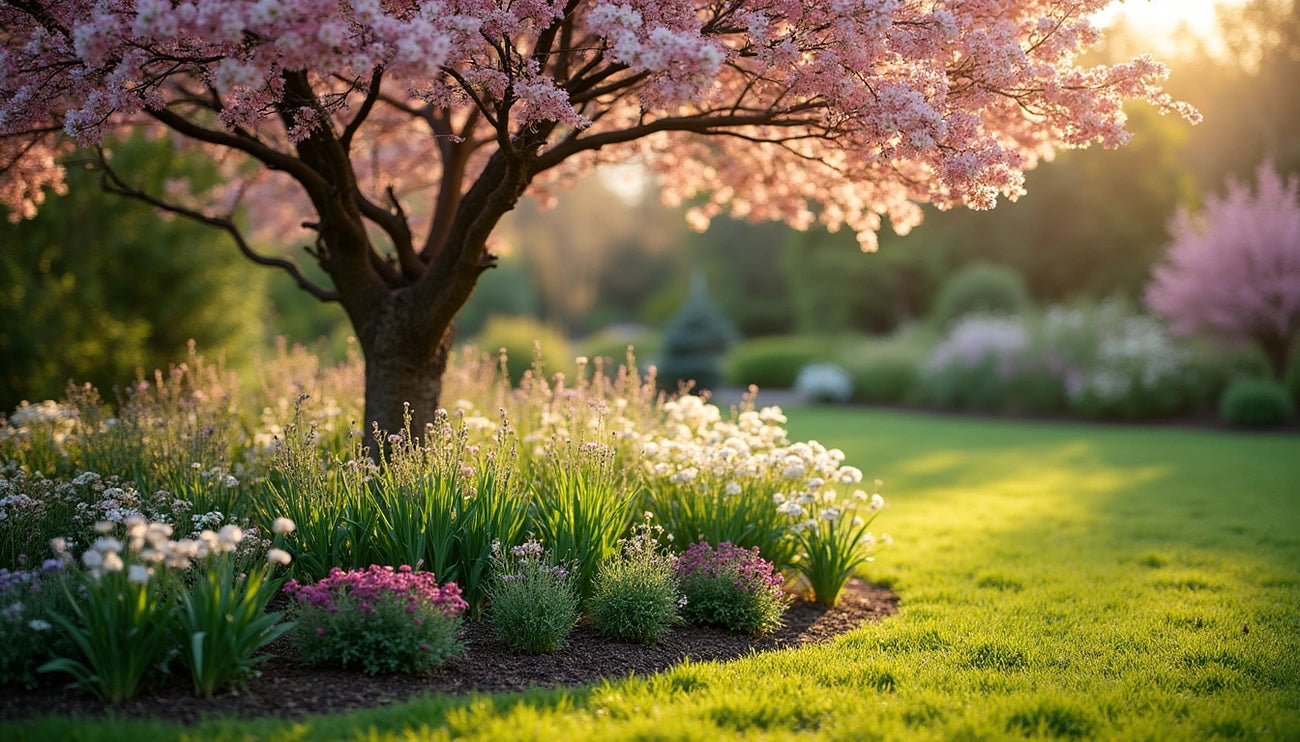Looking to learn how to propagate a crabapple tree? These stunning garden trees are not only compact—making them perfect for small gardens—but also provide year-round visual interest with spring blossoms, ornamental fruits, and vibrant autumn foliage.
While most potted crabapple trees take three to five years before flowering heavily, propagating your own can be a rewarding process. In fact, crabapple cuttings root fairly quickly under most conditions and will typically be ready for transplanting by early fall. However, it's worth noting that trees grown from cuttings might not maintain the same hardiness or performance as the parent tree.
In this comprehensive guide, we'll walk you through various methods of propagating crabapple trees, with special focus on taking cuttings—the most accessible approach for beginners. Whether you're interested in cloning apple trees or simply wondering if you can start a crabapple tree from a cutting, we've got you covered with expert-approved techniques that maximize your chances of success.
Choosing the Right Propagation Method
"The clearest way into the Universe is through a forest wilderness." — John Muir
First and foremost, understanding the various methods available for propagating crabapple trees will help you choose the approach that fits your experience level and goals.
Softwood cuttings vs. grafting vs. seeds
When considering how to propagate a crabapple tree, three main methods stand out:
- Softwood cuttings: These are taken from new, green growth during May or early June. Each cutting should be 4-6 inches long from the current season's growth. This method creates genetic clones of the parent tree.
- Grafting: Most weeping crabapples and named cultivars are traditionally propagated through grafting. This technique involves fusing the desired crabapple variety to a compatible rootstock. Grafting is particularly valuable for preserving specific ornamental qualities.
- Seeds: Growing from seeds is possible, nevertheless, hybrid varieties won't grow true to the parent plant. Seeds need to be stratified in the refrigerator for up to four months before planting.
How to propagate a flowering crabapple tree
For flowering crabapple trees, softwood cuttings generally offer the most accessible method. The process involves:
- Taking 4-6 inch cuttings from new growth
- Removing all but the top leaves
- Dipping the cut end in rooting hormone
- Planting in a well-draining medium like peat and perlite mix
Keep in mind that asexual propagation (cuttings) is the best way to reliably reproduce exact characteristics of the parent plant. This is especially important with flowering varieties where bloom color and pattern are desirable traits.
What works best for beginners
For those new to propagation, I recommend starting with softwood cuttings. Unlike hardwood cuttings which are typically difficult to root, softwood cuttings offer higher success rates and grow more quickly. Additionally, this method requires minimal specialized equipment.
Primarily, success depends on:
- Taking cuttings at the right time (spring to early summer)
- Using proper rooting hormone (IBA formulation works best)
- Maintaining even moisture without overwatering
- Providing indirect light during the rooting period
Remember that trees propagated from cuttings may not have the same hardiness as grafted specimens, although they often grow more vigorously once established.
Tools, Timing, and Preparation
Successful propagation of crabapple trees requires careful timing, proper tools, and the right environment. Mastering these fundamentals will significantly increase your chances of growing healthy trees from cuttings.
Best time of year to propagate crabapple trees
Timing is crucial when learning how to propagate a crabapple tree. For softwood cuttings, the optimal period is late May through early July from the current season's growth. During this time, the cutting material should be flexible yet mature enough to snap when sharply bent.
Alternatively, some varieties like 'Prairie Crabapple Spring Snow' respond better to propagation from mid-autumn to early winter. This cooler period provides optimal rooting conditions with reduced daylight, facilitating dormancy and less stress on the cuttings.
For dormant hardwood cuttings, winter or early spring works best when the tree is in its resting phase. Essentially, each approach has its ideal seasonal window for maximum success.
Essential tools and materials
To properly propagate crabapple trees, you'll need:
- Sharp, clean pruning shears - For taking precise cuts while minimizing damage to the plant
- Rooting hormone (IBA formulation) - To enhance root development
- Well-draining potting mix - Preferably containing peat moss, perlite, or coarse sand
- Propagation tray with drainage - Provides a controlled environment
- Humidity dome or plastic covering - Maintains essential moisture levels
- Heat mat - Supplies consistent warmth for root development
- Labeling stakes - For tracking growth progress
Step-by-Step: Propagating from Cuttings
Now that you understand the basics, let's dive into the detailed process of propagating crabapple trees from cuttings.
Selecting healthy branches
Initially, choose cuttings from non-flowering, disease-free shoots during the growing season. For optimal results, select stems that are pencil-sized, approximately 6-8 inches long with at least 3-4 nodes. The ideal cutting should be from new growth that is somewhat soft but not overly tender. Dormant cuttings can work too, yet they're typically slower to root.
Using rooting hormone effectively
Next, prepare your cutting by removing leaves from the bottom half to reduce moisture loss. Make a clean cut just below a node with sanitized shears. Dip the cut end into rooting hormone powder – this significantly increases your chances of successful propagation. For woody plants like crabapple trees, look for products containing IBA (Indole-3-butyric acid) rather than just IAA.
Creating the right environment for rooting
Insert the treated cutting into a well-draining medium consisting of peat and perlite or sand. Ensure the lower nodes are buried about 2-3 inches deep. Furthermore, cover with a plastic bag or dome to maintain humidity. Place in a warm location with indirect light.
Monitoring moisture and light
Throughout the rooting process, maintain consistent soil moisture without waterlogging. Regularly check for root development after 4-6 weeks. Once roots form, gradually acclimate the cutting to normal conditions by removing the cover periodically.
Troubleshooting and Success Tips
Even experienced gardeners face challenges when propagating crabapple trees. Understanding common problems helps avoid disappointment and increases your chances of success.
Why some cuttings fail to root
Propagation failures primarily occur due to overwatering, which leads to root rot and fungal infections that impede development. Using non-sterile tools introduces pathogens to fresh cuts, potentially causing disease outbreaks. Ignoring rooting hormone significantly lowers overall success rates. Moreover, planting cuttings too deeply restricts necessary air exchange, causing stems to rot before roots establish.
Signs of successful rooting
After approximately three weeks, new green growth often indicates developing roots. Eventually, you'll notice roots poking out from the bottom of containers—a definitive sign of success. Healthy leaves without black spots or discoloration likewise suggest proper development. Callus formation at the cutting's base marks the beginning of root production.
How to improve your success rate
To boost propagation success when learning how to propagate a crabapple tree:
- Ensure all cutting tools and pots remain sterile to prevent disease
- Apply appropriate rooting hormone—IBA formulations work better than IAA or weaker alternatives
- Insert cuttings shallowly with adequate support to prevent rot
- Maintain balanced soil moisture—damp but never soaked
When to give up and try again
Consequently, if black spots appear on leaves or stems turn black, remove and destroy affected cuttings immediately. Since most apples propagate readily as cuttings, dormant cuttings offer a more reliable alternative if summer attempts fail. Indeed, some varieties simply propagate better through air layering, which works quite well with crabapples.
Conclusion
Propagating crabapple trees offers a rewarding experience for gardeners of all skill levels. After all, these beautiful trees provide year-round visual interest while requiring minimal space in your garden. Though different propagation methods exist, softwood cuttings remain the most accessible approach for beginners due to their higher success rates and quicker growth.
Timing plays a crucial role in successful propagation. Therefore, marking your calendar for late spring to early summer will significantly improve your chances of success. Additionally, maintaining proper moisture levels and using quality rooting hormone can make the difference between thriving cuttings and disappointing results.
Most importantly, patience remains key throughout the propagation process. Roots typically develop within 6-8 weeks, but some varieties may take longer. Should your first attempt fail, remember that dormant cuttings or air layering provide excellent alternatives for propagating these ornamental trees.
We hope this guide has equipped you with the knowledge needed to grow your own crabapple trees. Undoubtedly, watching your cuttings develop into beautiful flowering trees brings immense satisfaction. If you prefer to start with established specimens, you can browse our selection of crabapple trees to find the perfect variety for your landscape.
Essentially, whether you choose to propagate from cuttings or start with nursery stock, crabapple trees will reward your efforts with stunning blossoms, ornamental fruits, and vibrant autumn foliage for years to come. Happy gardening!
FAQs
Q1. What is the best time of year to propagate crabapple trees? The optimal time for propagating crabapple trees is late spring to early summer, typically from late May through early July. This is when new growth is flexible yet mature enough for successful propagation.
Q2. Can I grow a crabapple tree from a cutting? Yes, you can grow a crabapple tree from a cutting. Softwood cuttings taken from new growth during the growing season are the most accessible method for beginners and often result in successful propagation.
Q3. How long does it take for crabapple cuttings to root? Crabapple cuttings typically root within 6-8 weeks. However, you may start checking for root development after 4-5 weeks. Signs of successful rooting include new green growth and roots poking out from the bottom of containers.
Q4. What tools do I need to propagate a crabapple tree? Essential tools for propagating crabapple trees include sharp, clean pruning shears, rooting hormone (preferably an IBA formulation), well-draining potting mix, a propagation tray with drainage, a humidity dome or plastic covering, and a heat mat.
Q5. Why might my crabapple cuttings fail to root? Crabapple cuttings may fail to root due to overwatering, using non-sterile tools, ignoring rooting hormone, or planting cuttings too deeply. Maintaining proper moisture levels, using sterile equipment, applying rooting hormone, and inserting cuttings at the right depth can improve success rates.




Leave a comment
This site is protected by hCaptcha and the hCaptcha Privacy Policy and Terms of Service apply.